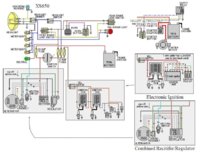dq212
XS650 Member
Hey all,
My buddy and I just finished wiring up the custom reg/rect from various instructions using the Chrysler regulator and the Radio Shack rectifiers. I also have some other mods to go with it.
My bike is a 75 XS650.
Pamco ignition.
I also have that tiny (cigarette box sized battery mod that some of you may have seen out there .8ah) I know, there are many opinions about this thing, but I'm determined to try for now at least. It's kick-only.
So with this setup it appears to be working well mostly, but when I turn the switch on, it drops dramatically, down to about 8V.
When I give it some throttle, it hops right back up. It's hard to get a solid reading but at times it seems to be over-charging, up to about 15V. I saw some other posts that said to clean some connections and the main fuse. It's all new and clean.
I also did the test for drop at the switch. What I don't know is if that test in particular should be done with the bike running or not. With the bike off and light on, the drop is significant. Several volts.
The instructions out there were not totally clear to me. But I'm trying my damnedest. This is what I did...
1. nylon screws on the top two and bottom right on the stator.
2. using the existing black wire still connected(via nylon screw), wired it to a 10amp fuse ( didn't have a 7.5 handy) and fed that to power after the ignition switch.
3. The green wire runs up into the regulator as does the now fused (formerly black only wire).
4. wired up the rectifiers as per the instructions going to the battery on the positive and the other to ground.
5. Stator yellow wires go to the rectifiers as well.
One part I got confused by was the use of the existing black wire. As I understood it, it stays put, connected to an in-line fuse and then to power, but now simply has a nylon screw at the stator to unground it. Is that correct?
The other questions are whether anyone out there knows that if by using that tiny battery, the massive voltage drop at the key switch turn is to be expected, and if there is any other obvious reason that I'm getting the occasional high recharge at 15V?
I know this is a thoroughly reviewed topic, but I haven't seen it done with this configuration. Any help would be greatly appreciated.
Regards,
-dq
My buddy and I just finished wiring up the custom reg/rect from various instructions using the Chrysler regulator and the Radio Shack rectifiers. I also have some other mods to go with it.
My bike is a 75 XS650.
Pamco ignition.
I also have that tiny (cigarette box sized battery mod that some of you may have seen out there .8ah) I know, there are many opinions about this thing, but I'm determined to try for now at least. It's kick-only.
So with this setup it appears to be working well mostly, but when I turn the switch on, it drops dramatically, down to about 8V.
When I give it some throttle, it hops right back up. It's hard to get a solid reading but at times it seems to be over-charging, up to about 15V. I saw some other posts that said to clean some connections and the main fuse. It's all new and clean.
I also did the test for drop at the switch. What I don't know is if that test in particular should be done with the bike running or not. With the bike off and light on, the drop is significant. Several volts.
The instructions out there were not totally clear to me. But I'm trying my damnedest. This is what I did...
1. nylon screws on the top two and bottom right on the stator.
2. using the existing black wire still connected(via nylon screw), wired it to a 10amp fuse ( didn't have a 7.5 handy) and fed that to power after the ignition switch.
3. The green wire runs up into the regulator as does the now fused (formerly black only wire).
4. wired up the rectifiers as per the instructions going to the battery on the positive and the other to ground.
5. Stator yellow wires go to the rectifiers as well.
One part I got confused by was the use of the existing black wire. As I understood it, it stays put, connected to an in-line fuse and then to power, but now simply has a nylon screw at the stator to unground it. Is that correct?
The other questions are whether anyone out there knows that if by using that tiny battery, the massive voltage drop at the key switch turn is to be expected, and if there is any other obvious reason that I'm getting the occasional high recharge at 15V?
I know this is a thoroughly reviewed topic, but I haven't seen it done with this configuration. Any help would be greatly appreciated.
Regards,
-dq
Last edited:


